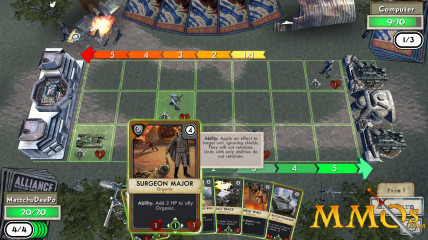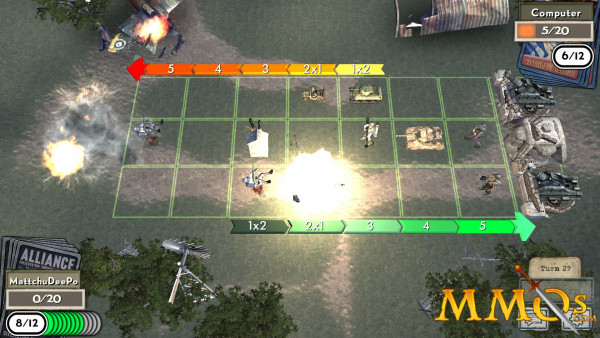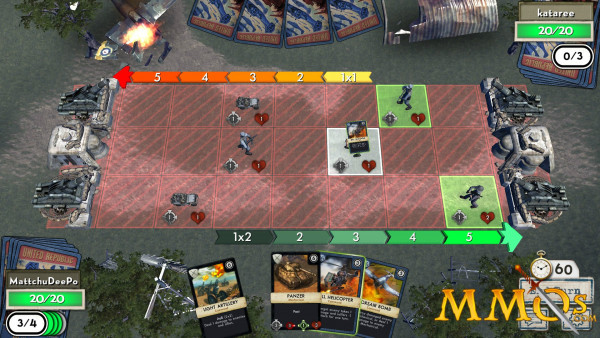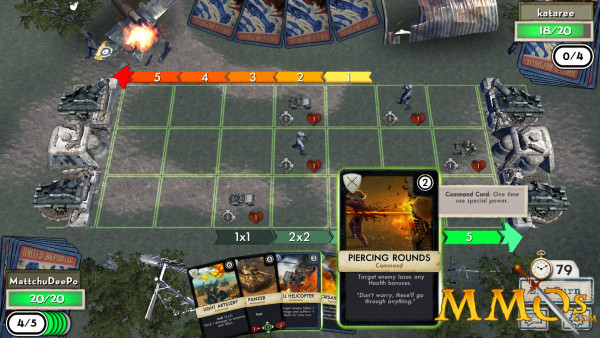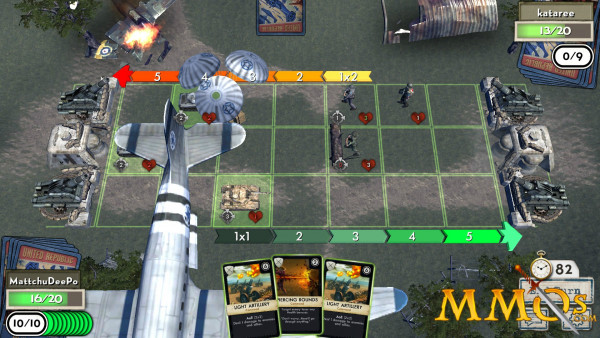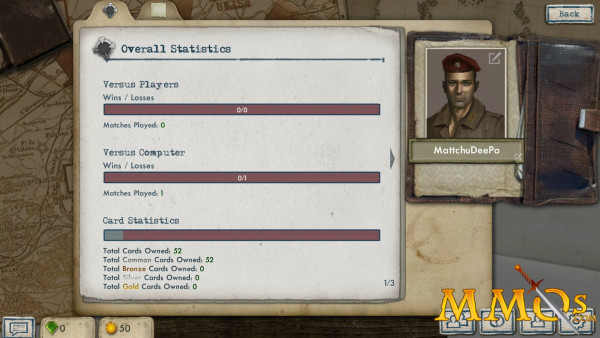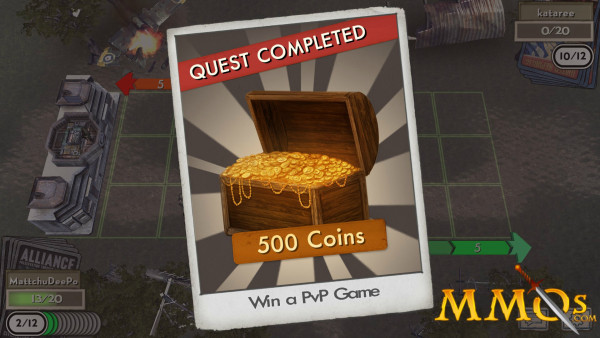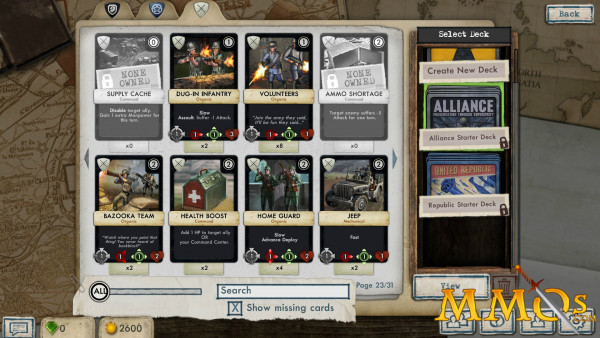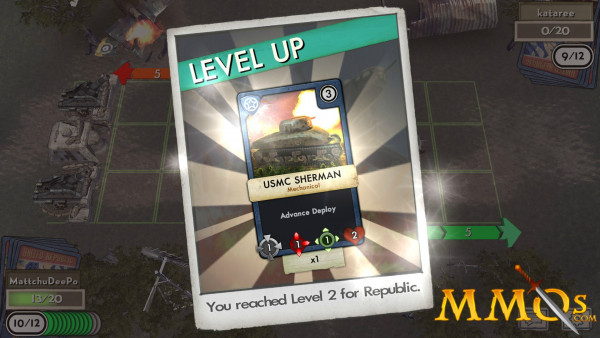March Of War: Face Off
March of War: Face Off is an easy to learn, hard to master mix of collectible card games and turn-based strategy games. The game takes familiar mechanics from Hearthstone and puts them into a fast-paced strategy setting where you take your opponent down by invading their side of the board.
| Publisher: ISOTX Playerbase: Shut Down Type: Turn-based strategy Release Date: July 16, 2015 Shut Down: March 29, 2016 Pros: +Easy to pick up and play. +Fast-paced tactical gameplay. +Big card library. Cons: -Lacks direction towards earning cards in the beginning. -Repetitive scenery. -Common card packs seem to give many of the same cards to different users. -Card variety is lacking. |
March of War: Face Off Overview
March of War: Face Off, created by Iron Grip: Warlord developers ISOTX, is a free-to-play game that is part collectible card game, part tactical, tile-based strategy game and combines familiar mechanics and ease of play from games like Hearthstone, with a tactical strategy component. The game focuses on dealing damage to your opponent indirectly by simply moving up the battlefield. Two factions with a variety of strong, slow units, weak, fast units, and Command cards will make up your deck as you attempt to rush the opponent’s Command Center. March of War: Face Off shut down in March, 2016.
March of War: Face Off Key Features:
- Fast-paced gameplay - matches are quick, typically taking 10-15 minutes.
- Two Game Genres: A mix of collectible card games and tile-based strategy games, build your deck and then lead your chosen units on the battlefield.
- Two factions - pick one of two factions, each with their own command center and cards.
- Huge card library - make a deck of thirty cards from over 220 different cards.
- PvP and PvE matches - play against the computer or climb the PvP ladder by playing against other players.
March of War: Face Off Screenshots
March of War: Face Off Featured Video
March of War: Face Off Review
By, Matt Chelen
There has been quite a rise in the amount of free-to-play collectible card games in recent times. Some, such as Hex and SolForge, aim to emulate Magic the Gathering’s depth and complexity, whereas others, such as Hearthstone, aim to go a simpler route. Others still, such as Duelyst and Scrolls, aim to seamlessly mix card games with a streamlined tactical strategy game component, often of a lane-based variety. ISOTX’s March of War: Face Off, a spin-off of their game March of War, aims to be more of the latter.
Gameplay
March of War: Face Off takes place entirely on a blank three by seven board with a command center on either end. Two dashed, numbered lines with arrows run down either side of the map, representing the amount of damage done to the command center for each unit that makes it to that column, called Domination Points. Your current hand can be seen at the bottom of the screen while the amount of cards in your deck can be checked by hovering over the deck graphic. Your command center’s health and your “Manpower”—simply a clever renaming of the generic “Mana Points”—are found on top of the deck graphic. Like games like Hearthstone, you gain an extra MP every turn, up to a maximum of 12. Also similar to Hearthstone, the player that goes second gets a card that gives them one extra Manpower for one turn.
The overall goal of the game can be broken down to pushing as many units as you can as far into enemy territory as you can in the quickest manner possible. Domination Points are translated into damage at the beginning of your turn and multiply as you push more units into columns that do damage, so you often find that you are trying to blitz, sacrificing units tactically rather than trying to preserve them. With a goal that encourages getting to the other side as fast as possible, stopping the enemy directly is a secondary goal. It’s important, as you need to make sure they don’t make it into your territory, but it doesn’t contribute to your win in a direct manner as in other games.
Given the faux-World War II setting the game takes place in, the design almost feels appropriate, as if the gameplay itself were designed entirely around the concept of blitzkrieg tactics. You will often find that the state of the game board will change quickly, as players use their sparse artillery and air support cards to wipe out those hanging in by a thread after the main force hits them. The late game is also decidedly ruled by heavy machinery, like tanks, rather than infantry or jeeps. There are several tactics that allow infantry to survive longer but they don’t hit hard enough to take down tanks alone. This is especially true for tanks that can fire an extra tile ahead.
Tactical Variety
Given the nature of the game, you’re often going to find that your tactics extremely similar, with differing nuances that depend on the cards you have. The starter decks for both factions aren’t very different from each other, containing more common cards than faction-specific cards, and thus you won’t be seeing a lot of variation when first starting out. As you earn more cards from packs you buy, and level up, the nuances will change but the overall tactics won’t. You will still be dropping various air support on your own units to heal them, or on enemies to hurt them. You will still be sending extremely similar tanks at your opponents, and you will still be starting each game with the same oddly useless infantry that are sent to die at the first thing they attack.
The core attributes that need to be looked at are those that affect Manpower long-term. If you have a deck full of units with the Slow attribute, you will potentially be doubling the amount of Manpower used on units per turn and getting nowhere fast. The power difference for these units is often negligible, such as 4 attack and 4 health for one Slow tank you start with, whereas one tank that has the Fast attribute—meaning that you don’t have to spend any Manpower to move it—has 3 attack and 3 health. Unit attacks, like many other games, don’t cost any Manpower. Somehow, this felt odd to me, perhaps due to the setting and term used, despite being a common feature.
Many of your early strategies will hinge on proper use of Medics. The aforementioned way to keep infantry alive longer is to keep buffing them each turn by keeping a medic nearby. Medics can’t attack but they do count towards your Domination Points, the same as any other unit, and can keep adding health points to one unit per turn indefinitely, even far beyond the unit’s base amount of health.
Other units, such as bunkers that can’t move, MG and bazooka units that can only attack diagonally like pawns in Chess, and entrenched units that have no attack due to an attack debuff placed on them—the distinction being that support cards can give them attack power, whereas the same cannot be said for medics—exist but they are a minority. A lot of the units feel very similar, providing only the aforementioned movement bonuses or penalties and attack and health differences. Those that are different tend to have a slightly different double, just the same as the others. The largest variety will come from the support cards and, even then, it feels as if many just provide different mixes of damage, additions to health, and pushing units back. A single card I earned allowed me to trade 3 Manpower for 5 in a single turn, which was a welcome change of pace.
Progression
Something about the overall progression provided in March of War: Face Off felt flat. Not unlike Hearthstone, you have your level for each faction, each level providing several new cards. You have quests that can be completed to earn more in-game currency, called gold, to purchase cards with, as well. The difference is that it feels random and unrewarding. I was given the objective of winning against the Republic faction when I first loaded up the game. Completing this objective gave me a staggering 2000 gold and unlocked the Republic faction.
Once that was complete, though, I was left with nothing until the next daily objective. Completing more games lead to random goal completions, such as killing an enemy medic for 50 gold, or my first win in a PvP game giving me 500 gold with subsequent wins giving 100 gold each, but I couldn’t work towards these if I wanted to, as they simply aren’t listed anywhere. The goals need to be unlocked through playing, leaving you to hope you’ve completed something you didn’t know about. Given the cost of card packs, it was a rather dissatisfying experience that left me wishing that I could find a list of objectives to work towards directly. The new player experience could be improved by giving varied goals that encourage different tactics or decks on the first day. In less than half an hour, I had completed the first objective and was unsure of what I was supposed to do from there to work towards more cards.
In terms of actually earning more cards, it can take some time. My first hour and a half of play left me with just enough gold to buy four common card packs, or twenty cards, many of which were repeats of those contained in the starter decks. The person I had been playing with had unlocked a similar amount of cards and received near identical cards to the ones I had. Later sessions had left me with less. If you want a chance at Bronze, Silver, or Gold cards, you seem to only be able to get those from the more expensive packs, which cost a staggering 3000 gold apiece—a price I hadn’t reached even with the starter objective and took some time to reach later. You can also buy packs that give you faction specific cards, should you want to stick with that faction, but they also cost 3000 gold. Or you could get them for two dollars per pack of five cards. Users estimate that you could receive up to 5 “normal” packs or 35 “common” packs per week but the average user probably won’t be putting that sort of time investment in. I’ve read that the starter decks have some of the most useful Command support cards, so there is a silver lining. Supposedly additional cards are there to “make the Republic faster and the Alliance tougher,” as one user put it. Additionally, there are less than 250 different cards in the game currently.
Beyond this, there’s a PvP ladder that seems to be climbed passively as you play more matches against real players. The top player right now has played under 1500 matches total and has over a two-to-one win ratio.
Presentation
The presentation of the game falls a bit short. The overall graphical quality is not great, probably around the higher end of mid-range mobile games, but that is not what I mean. I get that the game takes place in a World War II-esque setting and that they are trying to evoke the mood of a bleak battlefield but the fact of the matter is that there is a single, dull, largely gray and brown backdrop. The different factions have unique command centers, which is nice, but the fact that there are only two factions undermines this quite a bit, leaving you with the same two command centers in nearly every game. Similarly, there are only two card backs, one for each faction, and you cannot buy or earn more, as you can in games like Hearthstone.
The in-game interface manages to be satisfactory but the menu interface is simplistic to a fault and feels as if it were aimed at mobile platforms, despite the fact that the game is only available on PC currently. Large buttons abound and menus that scroll awkwardly when using the scroll wheel aren’t something you typically see in games developed natively for PC. The fact that the game’s tutorial tells you to “tap/click” doesn’t help that suspicion, either. Several minor actions, such as deploying units or building a deck, require you to click and drag without any alternatives. Little quirks like that build into an experience that isn’t quite as aggravating as many mobile ports are but can be a bit awkward.
Furthermore, the audio experience provided by March of War: Face Off is lackluster at best. While audio may not be quite as important for this genre of game, the fact that music will randomly disappear, leaving you with sparse gunfire, explosions, and consistently repeated two-to-three word sentences in various accents, is not ideal. If that weren’t enough, random actions appear to be missing sound entirely, leaving certain moments completely devoid of sound.
The game also suffers a number of connection issues. Given that ISOTX are an indie company based in the Netherlands, I would expect that the servers are based in Europe and that connecting from the United States would not be ideal. That being said, there were times when it took upwards of 15 to 20 seconds between the time one player hit the End Turn button and the time it told the other player their turn had started. There were also several times I experienced the game saying that I, or the other player, had disconnected, only to reconnect moments later.
Final Verdict - Good
March of War: Face Off is by no means a bad game. It plays solidly and the gameplay is fast-paced and fun, almost taking on a role I might call “to Scrolls what Hearthstone is to Magic the Gathering,” albeit less feature-rich. But there are several problems. If you even make it past your first few directionless hours of hoping you complete hidden objectives for cards, the game doesn’t encourage active play. Cards and a higher placement on a leaderboard-style, season-based PvP ladder are the only rewards. There don’t seem to be any major PvP events or tournaments that take place, other than ones being organized by the community. The game also sits in this awkward place where it doesn’t want to be a complex card game but it doesn’t want to eschew deckbuilding like Hero Academy, leaving it with little variation in both factions and tactics. With time, some of these issues could be fixed but, as it stands, March of War: Face Off is a game best played casually.
March of War: Face Off Videos
March of War: Face Off Links
March of War: Face Off Steam Store
March of War: Face Off Developer's Website
March of War: Face Off System Requirements
Minimum Requirements:
Operating System: Windows Vista, Windows 7 or Windows 8
CPU: Intel Core 2 Duo E4600 2.4 GHz AMD Athlon 64 X2 Duel Core 5200+
Video Card: nVidia GeForce 7 series or ATI Radeon HD 2000
RAM: 4 GB
Hard Disk Space: 1 GB
Recommended Requirements:
Operating System: Windows 7 Service Pack 1 64-Bit
CPU: Mid to High Range Dual-Core 2.5GHz CPU
Video Card: Nvidia GeForce GTX 285 or AMD Radeon HD 5830
RAM: 8 GB
Hard Disk Space: 1 GB
March of War: Face Off is Mac OS X compatible.
March of War: Face Off Music & Soundtrack
Coming Soon...
March of War: Face Off Additional Information
Developer(s): ISOTX
Publisher(s): ISOTX
Engine: Unity
Steam Early Access: April 10, 2015
Release Date: July 16, 2015
Steam Release Date: July 16, 2015
Shut Down: March 29, 2016
Development History / Background:
March of War: Face Off is developed in Unity by the Dutch company, ISOTX. A spin-off of their MMO turn-based strategy game, March of War. March of War: Face Off entered Early Access on Steam on April 10, 2015. After a successful Early Access period of approximately three months, the game entered into a full release state on July 16, 2015. March of War: Face Off shut down in March, 2016 without any formal announcement. It just disappeared.
